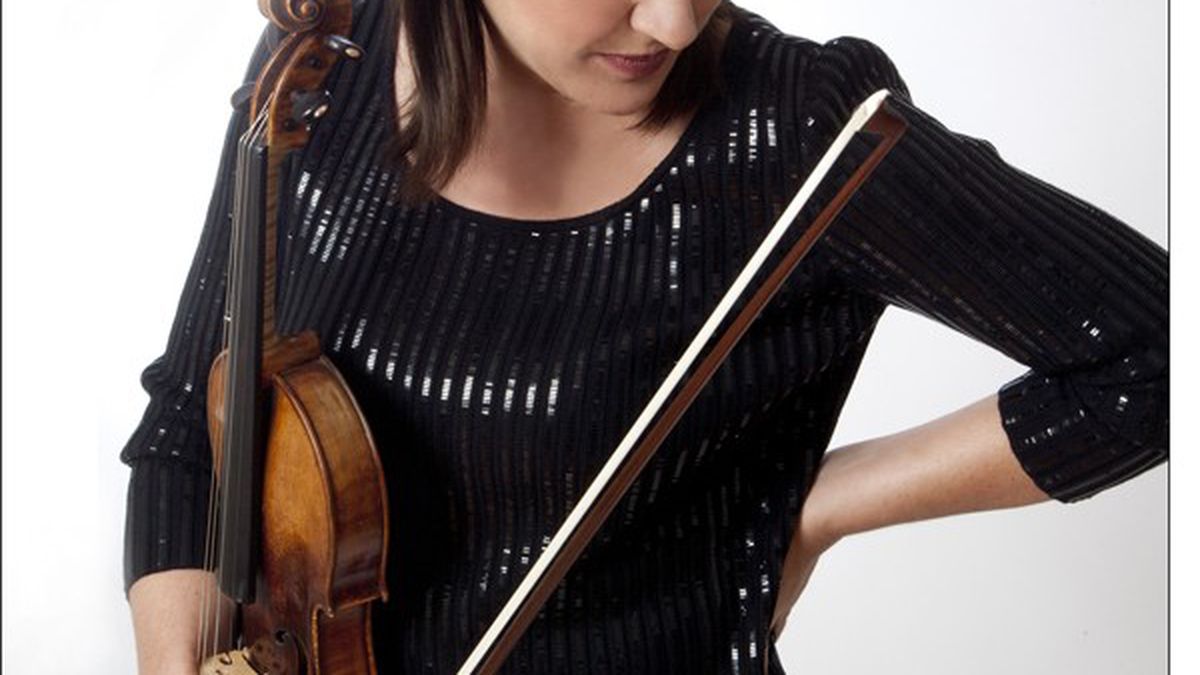Even during a phone interview, virtuoso violinist and New Century Chamber Orchestra (NCCO) Music Director Nadja Salerno-Sonnenberg is furiously fast. For anyone who’s seen her perform, it’s not hard to imagine her expressive, malleable face grimacing or grinning, furrowing and feeling every note of her rapid response. Without Skype, it’s impossible to know if she’s levitating off her chair — as she often appears to do onstage — or spiraling to slip on her signature, dagger-heeled performance stilettos, but it’s clear her mind moves allegro con brio.
With the final performances of NCCO’s 21st season — her fifth with the ensemble — just two days away when we spoke, Salerno-Sonnenberg’s brain is split not just into two hemispheres like the rest of us mere mortals, but between the past, present, and future.
“There’s been a slow steady growth of knowing each other,” Salerno-Sonnenberg said about the role she assumed in 2008. “The direction I took from the first is exactly the same as we go forward: to get the musicians to play in a vibrant way, to get them recognized.”
When Salerno-Sonnenberg first came onboard, San Francisco’s NCCO was minimally known but consistently heralded for its democratic, conductorless string ensemble configuration and its ability to attract high-caliber musicians. A history of sporadic touring and recording (including the exquisite Grammy nominee, Written With the Heart’s Blood, released in 2009) did little to lift the orchestra above obscurity in the Bay Area’s bustling music scene. Despite the group’s dignified founders — cellist Miriam Perkoff and violist Wieslaw Pogorzelski, and reputable directors, including Stuart Canin and Krista Bennion Feeney — NCCO was ripe for an incendiary spark.
Capable of blazing as a solo violinist, Salerno-Sonnenberg has, by many accounts, set the group on fire. National and Bay Area reviews compose a steady drumbeat of praise. The New York Times noted its “churning intensity” and “homogeneous sonority” in a 2011 review. AnnArbor.com called NCCO “electric” in response to its January 2013 appearance. And San Francisco Classical Voice described a recently released DVD, On Our Way, as “masterful in every way.”
“If I’ve decided I want to go off a cliff, the entire group follows me,” Salerno-Sonnenberg said, chuckling with pleasure. But lest you think it’s all a party, Salerno-Sonnenberg is quick to point out the hard work behind the magic.
“The job has been more burdensome than I imagined,” she said. “It’s like having a child; the responsibility is huge. Even when we’re not together, I’m constantly working on putting programs together.”
The challenge of creating a program both cohesive and novel is enormous, especially given the dearth of string orchestra repertoire. The genre’s limited library has caused her to “program out of the box.” Unlocking not-just-nice-but-new-to-NCCO works has meant two things: more partnerships with other groups and a composer-in-residence each season.
This year’s season-closing concert, at Berkeley’s First Congregational Church on May 23, revealed the majesty of both aspects. Horns and winds enriched the alchemy of sound, especially in “Sinfonia for Strings (Memoria de la luz),” a world premiere by Russian-born American and 2012-13 resident composer Lera Auerbach. The work’s thematic material wandered like an unsettled ghost from one solo musician to the next, while the rest groaned like restless giants before bursting to the surface as if they’d been held captive underwater far too long. In a brief solo passage, the music seemed to come out of Salerno-Sonnenberg’s spine, as much as from her instrument. Although her peers didn’t bob, sway, lunge, and weave like she did, their playing was equally energetic and expressive: “This is an orchestra that needs to be seen because they radiate joy when they play,” she said, two days prior to the show.
Indeed, NCCO musicians are masters of texture and transition, a fact made apparent in the night’s final selection, Franz Joseph Haydn’s “Symphony No. 45 in F-sharp Minor (Farewell).” The first movement’s bristling zest was perfectly balanced by the adagio’s serenity. The third movement — logical until an abrupt, unresolved ending — set a precise, contrasting field for the symphony’s finale, played with remarkable power by the 24 musicians. In this piece, and in Richard Wagner’s tender “Siegfried Idyll,” the lush, tonal coloration, enhanced by the addition of a half-dozen, individually spectacular guest musicians, completed NCCO’s richly varied program.
Next year’s season suggests this year’s ambition was simply a warm-up. With a new recording, a jazz-infused collaboration with all-male chorus Chanticleer, an opera program, and a Michael Daugherty-composed world premiere violin concerto on tap, Salerno-Sonnenberg and her “child” will be busy.
When asked to identify the frontiers — more tours, radio broadcasts, recordings, collaborations, new music from all over the world — she expects to explore, Salerno-Sonnenberg replied with her fastest response of all: “Yes,” she said crisply, “yes to all.” And with that, she was off, racing to rehearsal.












